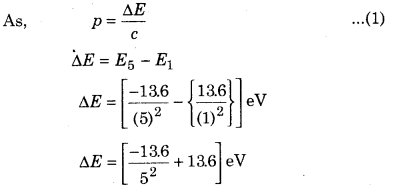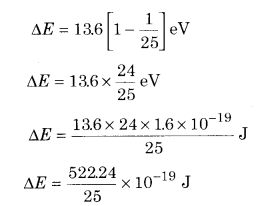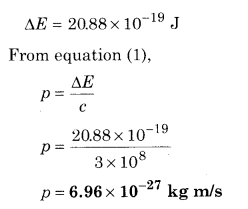Rajasthan Board RBSE Class 12 Physics Chapter 14 Atomic Physics
RBSE Class 12 Physics Chapter 14 Text Book Exercise with Answers
RBSE Class 12 Physics Chapter 14 Multiple Choice Type Questions
Question 1.
The ground state energy of hydrogen atom is -13.6 eV. What will be its energy for n = 5 level ?
(a) -0.54 eV
(b) -0.85 eV
(c) -5.4 eV
(d) -2.72 eV
Answer:
(a) -0.54 eV
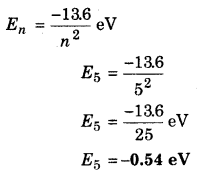
Question 2.
The energy of hydrogen atom in nth orbit is En = \(-\frac { 136 }{ { n }^{ 2 } } \), eV. Calculate the energy necessary to send electron from first orbit to second orbit:
(a) 10.2 eV
(b) 12.1 eV
(c) 13.0eV
(d) 3.4 eV
Answer:
(a) 10.2 eV
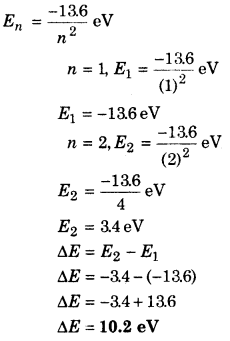
Question 3.
In hydrogen atom if electron transit from 3rd orbit to 2nd orbit, then wavelength of the emitted radiation will be :

Answer:
(c)
\(\frac{1}{\lambda}=R\left[\frac{1}{n_{1}^{2}}-\frac{1}{n_{2}^{2}}\right]\)
n1 = 2, n2 = 3
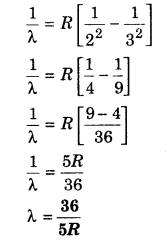
Question 4.
In which part of the electromagnetic spectrum the Lyman series of hydrogen is found?
(a) ultraviolet
(b) infrared
(c) visible
(d) X-ray region
Answer:
(a) ultraviolet
Question 5.
A hydrogen atom is excited to energy level n = 4 Calculate the emitted spectrum lines :
(a) 2
(b) 3
(c) 4
(d) 6
Answer:
(d) 6
NE = \(\frac{n(n-1)}{2}\)
NE = \(\frac{4(4-1)}{2}\)
NE = 6
Question 6.
Minimum and maximum wavelengths for Lyman series of hydrogen are :
(a) 909 Å and 1212 Å
(b) 9091 Å and 12120 Å
(c) 303 Å and 404 Å
(d) 1000 Å and 3000 Å
Answer:
(a) 909 Å and 1212 Å
\(\frac{1}{\lambda}=R\left[\frac{1}{(1)^{2}}-\frac{1}{n_{2}^{2}}\right]\)
For maximum wavelength n2 = 2
λmax = 1212 Å
For maximum wavelength n2 = ∞
λmin = 909 Å
Question 7.
In excited hydrogen atom according to Bohr’s theory if angular momentum is \(\left(\frac{2 h}{2 \pi}\right)\) , then its energy will be :
(a) -13.6 eV
(b) -13.4 eV
(c) -3.4 eV
(d) -12.8 eV
Answer:
(c) -3.4 eV
According to Bohr’s second postulate
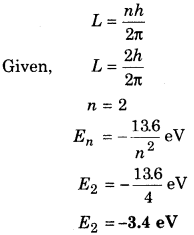
Question 8.
What will be the principal quantum number of the excited state in which hydrogen atom after emission of wavelength λ return to its ground state?
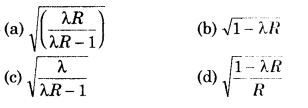
Answer:
(a)
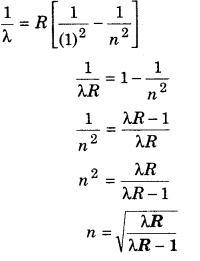
Question 9.
In the following constants which is equal to ground states for all hydrogen similar ions?
(a) orbital speed of electron
(b) radius of orbit
(c) angular momentum of electron
(d) energy of the atom
Answer:
(c) angular momentum of electron
Question 10.
The ground state energy of an hydrogen similar ion is -54.4 eV. It may be :
(a) He+
(b) Li ++
(c) Deuterium+
(d) Be+++
Answer:
(a) He+
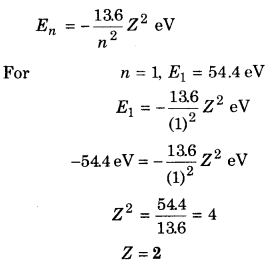
For atomic number 2 it will be He+
Question 11.
On increase in the value of principal quantum number in hydrogen atom, the potential energy of the atom :
(a) decreases
(b) increases
(c) remains same
(d) potential energy increases and decreases alternatively
Answer:
(a) decreases
Question 12.
Hydrogen atom can transit from n = 4 to n = 1 state. Then what will be projection momentum of hydrogen atom (in eV/c)?
(a) 13.60
(b) 12.75
(c) 0.85
(d) 22.1
Answer:
(b) 12.75
Momentum of deflected Hydrogen = Momentum of emitted photon
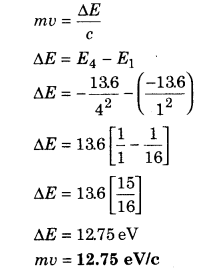
Question 13.
In the nth class of hydrogen atom (angular momentum L), the magnetic moment due to orbital motion of electron is :
![]()
Answer:
(b)
Magnetic dipole moment
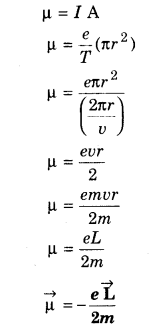
Question 14.
When an hydrogen atom transit from ground state to first excited state, then increase in its angular momentum is :
(a) 6.63 × 10-34 J-s
(b) 1.05 × 10-34 J-s
(c) 41.5 × 10-34 J-s
(d) 2.11 × 10-34 J-s
Answer:
(b) 1.05 × 10-34 J-s
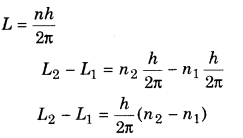
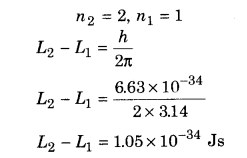
RBSE Class 12 Physics Chapter 14 Very Short Answer Type Questions
Question 1.
Most of the positive charge of the atom is centralised in a small centre. By which experiment it was proved?
Answer:
Rutherford a-ray scattering experiment.
Question 2.
Write two shortcomings of Rutherford model.
Answer:
- It does not explain linear spectrum.
- It does not explain stability of atom.
Question 3.
If angular momentum of the electron in hydrogen atom is \(\frac{h}{\pi}\), then in which class it will be n situated?
Answer:
L = \(\frac{n h}{2 \pi}\), if n = 2 .
Then, L = \(\frac{h}{\pi}\)
So, atom will be in second orbit.
Question 4.
Lyman series of hydrogen lies in which part of electromagnetic spectrum?
Answer:
In ultraviolet region.
Question 5.
In first Bohr orbit of hydrogen similar atom the energy of electron is -27.2 eV. What will be its energy in third Bohr orbit?
Answer:
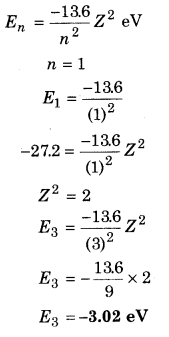
Question 6.
What will be the relation of radius of different classes of hydrogen atom?
Answer:
rn = \(\frac{\epsilon_{0} h^{2}}{\pi m Z e^{2}} n^{2}\)
rn = n2r1
r1 : r2 : r3 = (1)2 : (2)2 : (3)2 ……….
= 1 : 4 : 9 ……….
Question 7.
What will be the electron’s potential energy in eV in first orbit of hydrogen atom?
Answer:
Potential energy Un = \(-\frac{K Z e^{2}}{r_{n}}\)
Total energy En = \(-\frac{1}{2} \frac{K Z e^{2}}{r_{n}}\)
En = \(\frac{1}{2}\) (Un)
Un = 2En
Total energy in first orbit En = -13.6 eV
Un = 2(-13.6)eV
Un = -27.2 eV
Question 8.
If radius of first Bohr orbit in hydrogen atom is 0.5 Å, then what will be radius in fourth Bohr orbit?
Answer:
rn = n2r1
r4 = (4)2 (0.5) Å
r4 =(16 × 0.5) Å
r4 = 8.0 Å
Question 9.
Calculate the wavelength of the last line of Balmer series.
Answer:
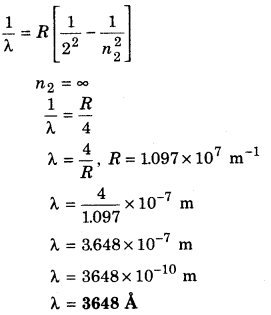
Question 10.
Write mathematical formulae for angular momentum related to quantisation in Bohr’s theory.
Answer:
L = \(n \frac{h}{2 \pi}\)
where, = L = mvnrn
mvnrn = \(\frac{n h}{2 \pi}\)
Question 11.
Write name of the series of hydrogen spectrum for which same lines lie in visible light region.
Answer:
Balmer series.
Question 12.
By which hypothesis Bohr’s second postulate can be summarised?
Answer:
de-Broglie matter wave hypothesis.
RBSE Class 12 Physics Chapter 14 Short Answer Type Questions
Question 1.
Describe shortcomings of Thomson atomic model.
Answer:
Thomson model was discarded later on due to the following drawbacks :
- It could not explain the origin of several spectral series in the case of hydrogen and other atoms.
- It failed to explain the large angle scattering of a-particles in Rutherford’s experiment.
Question 2.
Describe Rutherford’s model of the atom.
Answer:
Rutherford’s Atomic Model
In 1911 Rutherford presented a model in relation to the atomic structure based on finding from his scattering experiment of a-particles. According to this model.
- An atom consists of a small and massive central core in which the entire positive charge and almost the whole mass of the atom are concentrated. This core is called the nucleus.
- The size of the nucleus (≈ 10-15m)is very small as compared to the size of the atom (≈ 10-10 m). The nucleus is surrounded by a suitable number of electrons so that their total negative charge is equal to the total positive charge on the nucleus and the atom as a whole is electrically neutral.
- If electrons are at rest then they should fall down in nucleus due to Coulomb attraction force but the electrons revolve around the nucleus in various orbits just as planets revolve around the sun. The centripetal force required for their revolution is provided by the electrostatic attraction between the electrons and the nucleus.
Question 3.
Describe in brief how Rutherford’s model was not able to explain the stability of the atom.
Answer:
Drawbacks of Rutherford’s Atomic Model
Inspite of this model there are some limitations of Rutherford’s atomic model. According to electromagnetic theory an accelerated charged particle must radiate electromagnetic radiation. An electron revolving around the nucleus is under continuous acceleration towards the centre. It should continuously loses energy and move in orbits of gradually decreasing radii. The electron should follow a spiral path and finally it should collapse into the nucleus. Thus the Rutherford’s model cannot explain the stability of an atom. In Rutherford’s model, an electron can revolve in orbits of all possible Fig. 14.8 : Electron radii. So it should emit a according to.model continuous spectrum. But an atom like hydrogen always emits a discrete line spectrum.
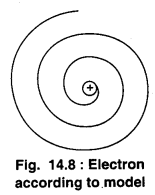
Question 4.
Write shortcomings of Bohr’s theory.
Answer:
Limitations of Bohr Model
Bohr model has many limitations. Some are given here :
- The Bohr model is applicable to hydrogenic atoms. It cannot be extended even to more two electron atoms such as helium. The analysis of atoms with more than one electron was attempted on the lines of Bohr’s model for hydrogenic atoms but did not meet with any success. Difficulty lies in the fact that each electron interacts not only with the positively charged nucleus but also with all other electrons.
- It does not explain why only circular orbits should be chosen when elliptical orbits are also possible.
- In the spectrum of hydrogen, certain spectral lines are not single lines but a group of closed lines with slightly different frequencies. Bohr’s theory could not explain these fine structures of the hydrogen spectrum.
- Bohr’s theory does not tell anything about the relative intensities of the various spectral lines. Bohr’s theory predicts only the frequencies of these lines.
- It does not explain the further splitting of spectral lines in a magnetic field (Zeeman effect) or in an electric field (Stark effect).
- The formulation of Bohr model involves electrical force between positively charged nucleus and electron. It does not include the electrical forces between electrons which necessarily appear in multi-electron atoms.
Question 5.
Hydrogen atom contains one electron but its emission spectrum consists of so many lines. How it is possible? Describe in brief.
Answer:
A source of hydrogen spectrum has billions of hydrogen atoms. Each hydrogen atom has many stationary states. All possible transitions can occur from any higher level to any lower level. This gives rise to a large number of spectral lines.
Question 6.
How linear spectrum study is helpful in determination of elements?
Answer:
Every element has fixed energy level of its atoms. They are different from energy level of other elements. So radiation emitted by any one element has fixed frequency lines. They are different for each element. So linear spectrum specify character of each element.
Question 7.
In a sample of hydrogen gas mostly atoms are in n = 1 energy level. On passing visible light through this gas some spectrum lines are absorbed. Which lines (Lyman or Balmer) spectrum are absorbed maximum and why?
Answer:
We get only Lyman series in absorption spectrum of hydrogen atom. Because in normal state all atoms are in lower state (n = 1).
Question 8.
What do you mean by stable orbit of the electron? What is the condition for it?
Answer:
While revolving in the permissible orbits, an electron does not radiate energy. These non-radiating orbit s are called stationary orbits.
Condition : For these orbits, the electrons are permitted to circulate only in such orbits in which the angular momentum of an electron is an integral multiple of \(\frac{h}{2 \pi}\), h being Planck’s constant.
Question 9.
Balmer series was found firstly and analysed firstly than other lines. What is the cause of this reason?
Answer:
Some lines of Balmer series are found in visible region. So they are firstly observed and analysed.
Question 10.
The magnitude of total energy of nth orbit in Bohr model is \(\left|E_{n}\right|\) and angular momentum is Ln. What is the relation between them?
Answer:
En = \(\frac{Z^{2} e^{4} m}{8 \varepsilon_{0}^{2} n^{2} h^{2}}\) ………….. (1)
From Bohr’s second postulate
Ln = \(\frac{n h}{2 \pi}\) ……………….. (2)
From relation (2), nh = 2πLn
Putting value of nh in equation (1),
\(\left|E_{n}\right|=\left[\frac{Z^{2} e^{4} m}{8 \varepsilon_{0}^{2}}\right] \frac{1}{\left(2 \pi L_{n}\right)^{2}}\)
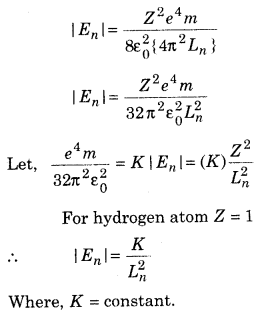
RBSE Class 12 Physics Chapter 14 Long Answer Type Questions
Question 1.
Describe Rutherford’s experiment on scattering of α-particles. How do it help in discovery of nucleus?
Answer:
Alpha Ray Scattering Experiment and Rutherford Model of Atom
In 1911, scientist Rutherford and his two colleagues Geiger and Marsden, used an experiment to detect the structure of atom whose outline is shown in figure 14.2.
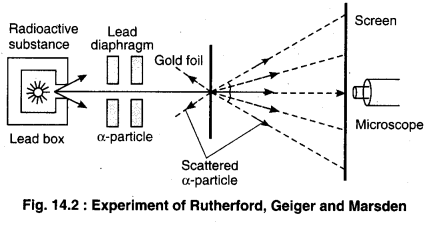
In this experiment a radioactive substance polonium (or Radon) placed in lead box A. The α-particle (which are actually the Helium atoms 2He4 nucleus) of high kinetic energy emanate from this box. After diaphragm D1 and D2, a-particles are collimated on a thin gold foil G in the form of a narrow beam. The thickness of gold foil is about 10-5 cm and due to its thin pin, α-particle deflects through a single collision. Gold foil is taken becasue (i) Gold foil can be made very thin, (ii) The gold nucleus is heavy for α-particle deflection.
Rutherford observed that α-particles passing through foil deflected in different directions. The occurrence of deflection from its path due to the collision of atoms of matter of alpha particles is called scattering. The scattered α-particles are focussed on a fluorescent screen S, from which each α-particle generates an fluorescence. Fluorescence generated in a certain direction can be counted by moving the microscope in any direction, meaning that the α-particle can be counted in that direction. A fluorescence counter also be used in the place of fluorescent screen and microscope. This complete management is kept in vaccum so that there is no collision of α-particle with any air particle.
(i) “The most of α-particles pass straight through the gold foil.” With this test, Rutherford concluded that most of the atom is hollow. It is clear the this is against the Thomson’s nuclear model. According to Thomson, atom is a solid ball of positive charge. If atom is a solid ball then how α-particles based through it.
(ii) “Some α-particles are deflected from their path with small angle.” The α-particle has positive charge so its scattering is possible only with some positive charge item. Thus Rutherford concluded that the total positive ions should be concentrated in one place. Through this test Thomson’s model was rejected, according to which the amount of positive charge is distributed evenly at the atom.
(iii) “Very small number of α-particles (one in 8000) display posterior scattering meaning deflected at 90° or more angle from their route or returning back.” From this test it was concluded that the concentration of all mass of the atom is at very area, which scattered nucleus. All mass of atom is also concentrated in the nucleus.
The size of the atom will be as small, the α-particles will reach the nucleus i.e., lesser the number of α-particles being scattered over angle 90°.
On calculation, the radius of nucleus is only 10000th in size of the atom. The remaining empty space of the atom contains only electrons.
Postulate of the nucleus is the most important fact of the structure of the atom and this gives a successful interpretation of Rutherford’s experimental result. Rutherford has interpretated his test as figure 14.3. It is clear from the figure that the α-particles that are far away from the nucleus, they cross right away without distracting foil. As the α-particle approaches the nucleus, the scattering begins. The scattering angle increases when they move towards nucleus.
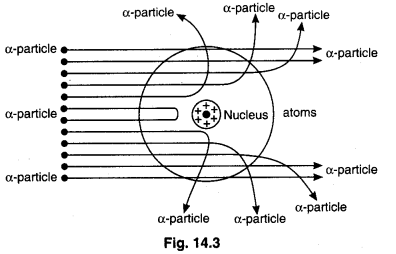
(iv) Experiment of α-particles scattering proved the Coulomb’s law. Rutherford believed that the repulsive force that takes place between the positive α-particles and positive nucleus is given by Coulomb’s law.
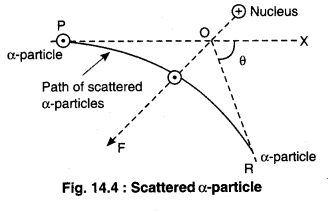
That is, the repulsive force is inversely proportional to the square of distance from the nucleus of the particle. Due to this force the direction of α-particle becomes hyperbolic as shown in the figure 14.4. As the value of distance ‘r’ decreases, the value of F increases rapidly. Therefore, when passing through the atom, the repulsive force on which the particle stays away from the nucleus is less, so that it goes straight to initial path without being deflected, but as far as the alpha particle passes near the nucleus, the more repulsive force it feels, and the result is that it is scattering by the more angle (figure 14.5). The change of scattering angle θ with the distance r of the α-particle from the nucleus is shown in figure 14.6. In this experiment the change of the scattered angle can not be known for the distance of a particular α particle.
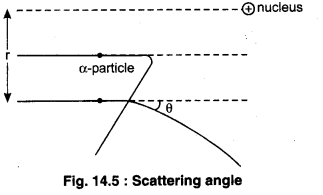
So, the graph can not be drawn in experimental form. Rutherford computed the number of α-particles scattered at various angles. Based on the Coulomb’s law and they found the number of particles (N) that are scattered at an angle (θ) is inversely proportional to sin4 (θ/ 2). i.e.,
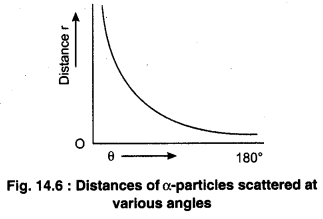
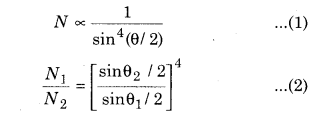
The graph between N and θ is shown in figure 14.7. This relation proved to be true by the experiment of Geiger and Marsden in 1993. This concludes that the dispersion of α-particles by the nucleus is according to the Coulomb’s law which is also applicable to atomic distances (to 10-14 m).
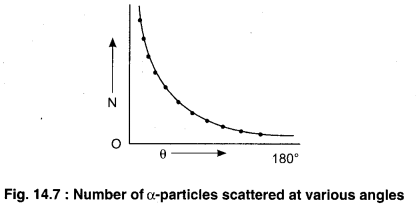
(v) Rutherford extracted the number of α-particles scattered in a certain direction from foil of various metals (like-gold, silver and platinum etc.) by experiments and found that this number is different for different metal foil. Therefore they concluded that the amount of positive charge differ in the nuclei of different metals. The high positive charge in the nucleus, the α-particle will be repelled by the more force than that nucleus of less change.
Rutherford calculate the numebr of α-particles that are scattered at a certain angle and range is proportional to the square of positive charge in the metal and nucleus.
On this basis in 1920, the scientist Chadwick found that the quantity of positive charge in the metal nucleus is Ze, where Z is a constant for the metal. It is known as atomic number and e is a charge of electron.
Distance of closest approach (size of nucleus): The minimum distance from the nucleus up to which an energetic α-particle travelling directly towards the nucleus can move before coming to rest and retrace its own path is known as distance of closest approach. This distance is represented by r0.
Rutherford made the following assumptions for the calculation of distance :
(i) The atomic nucleus is so heavy that it’s motion during the impact is diregarded.
(ii) The nucleus and the alpha particle both are taken as point charges having no dimensions.
(iii) The scattering is due to elastic collosion between nucleus and α-particle.
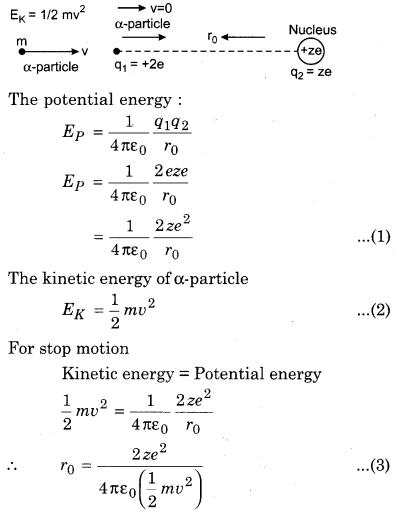
Impact parameter : It is defined as the perpendicular distance of the initial velocity vector of the alpha particle from the central line of the nucleus, when the particle is far away from the nucleus of the atom. In fact, impact parameter determine the trajectory traced by an alpha particle in passing through the gold foil.
The impact parameter ‘b’ is calculated by the formula :
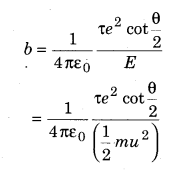
Question 2.
What are the shortcomings of Rutherford model. How are these shortcomings was removed by Bohr in his model?
Answer:
Drawbacks of Rutherford’s Atomic Model
Inspite of this model there are some limitations of Rutherford’s atomic model. According to electromagnetic theory an accelerated charged particle must radiate electromagnetic radiation. An electron revolving around the nucleus is under continuous acceleration towards the centre. It should continuously loses energy and move in orbits of gradually decreasing radii. The electron should follow a spiral path and finally it should collapse into the nucleus. Thus the Rutherford’s model cannot explain the stability of an atom. In Rutherford’s model, an electron can revolve in orbits of all possible Fig. 14.8 : Electron radii. So it should emit a according to.model continuous spectrum. But an atom like hydrogen always emits a discrete line spectrum.

Bohr Model for Hydrogen Atom and Hydrogen Like Ions:
The drawbacks of Rutherford model were removed by Niels Bohr in 1913. Bohr proposed a new atom model. He applied the quantum theory of radiation, as developed by Max Planck and Einstein, to the Rutherford model.
Following are the postulates of the Bohr’s theory.
1. An atom consists of a small and massive central core, called nucleus around which planetary electrons are revolving. The centripetal force required for their rotation is provided by the electostatic attraction between the electrons and the nucleus. While revolving in the permissible orbits, an electron does not radiate energy. These non-radiating orbits are called ‘stationary orbits’
Fcoulomb = Fcentripetal
If an electron moves around the nucleus of the charge, Ze in the nth stable orbit, then
\(\frac{k(Z e) e}{r_{n}^{2}}=\frac{m v_{n}^{2}}{r_{n}}\)
Where rn is the radius of nth orbit and vn is the velocity of electron in nth orbit. So,
Then the frequency v of the emitted or absorbedWhere rn is the radius of nth orbit and vn is the velocity of electron in nth orbit. So,
\(\frac{k(Z e) e}{r_{n}^{2}}=\frac{m v_{n}^{2}}{r_{n}}\) ……………… (i)
2. According to the second postulate the electrons are permitted to revolve only in those orbits in which the angular momentum of an electron is an integral multiple of \(\frac{n}{2 \pi}\), h being Planck’s constant.
These orbits are called stable orbits. If mass of electron is m, orbital velocity is v and radius of orbit is r, then

3. An atom can emit or absorb radiation in the form of discrete energy photons only when an electron jumps from a higher to a lower orbit or from a lower to a higher orbit, respectively. If En1 and En2 are the energies associated with these permitted orbits.
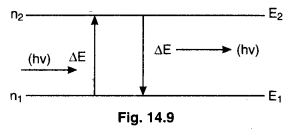
Then the frequency v of the emitted of absorbed were radiation is given by,
En2 – En1 = hv = \(\frac{h c}{\lambda}\)
This is known as Bohr’s frequency condition
Question 3.
State Bohr’s postulates for explaining the spectrum of hydrogen atoms. Derive a formula for total energy of electron in n orbit.
Answer:
Bohr Model for Hydrogen Atom and Hydrogen Like Ions:
The drawbacks of Rutherford model were removed by Niels Bohr in 1913. Bohr proposed a new atom model. He applied the quantum theory of radiation, as developed by Max Planck and Einstein, to the Rutherford model.
Following are the postulates of the Bohr’s theory.
1. An atom consists of a small and massive central core, called nucleus around which planetary electrons are revolving. The centripetal force required for their rotation is provided by the electostatic attraction between the electrons and the nucleus. While revolving in the permissible orbits, an electron does not radiate energy. These non-radiating orbits are called ‘stationary orbits’
Fcoulomb = Fcentripetal
If an electron moves around the nucleus of the charge, Ze in the nth stable orbit, then
\(\frac{k(Z e) e}{r_{n}^{2}}=\frac{m v_{n}^{2}}{r_{n}}\)
Where rn is the radius of nth orbit and vn is the velocity of electron in nth orbit. So,
Then the frequency v of the emitted or absorbedWhere rn is the radius of nth orbit and vn is the velocity of electron in nth orbit. So,
\(\frac{k(Z e) e}{r_{n}^{2}}=\frac{m v_{n}^{2}}{r_{n}}\) ……………… (i)
2. According to the second postulate the electrons are permitted to revolve only in those orbits in which the angular momentum of an electron is an integral multiple of \(\frac{n}{2 \pi}\), h being Planck’s constant.
These orbits are called stable orbits. If mass of electron is m, orbital velocity is v and radius of orbit is r, then

3. An atom can emit or absorb radiation in the form of discrete energy photons only when an electron jumps from a higher to a lower orbit or from a lower to a higher orbit, respectively. If En1 and En2 are the energies associated with these permitted orbits.

Then the frequency v of the emitted of absorbed were radiation is given by,
En2 – En1 = hv = \(\frac{h c}{\lambda}\)
This is known as Bohr’s frequency condition
Total Energy of Electron in nth Orbit
Total energy (El) in any stable orbit class is equal to the sum of the kinetic energy and potential energy. Kinetic energy of electron.
Kn = \(\frac{1}{2}\) mv2
From equation (2) in Article number 14.3.1
v2 = \(\frac{1}{4 \pi \varepsilon_{0}} \frac{Z e^{2}}{m r_{n}}\)
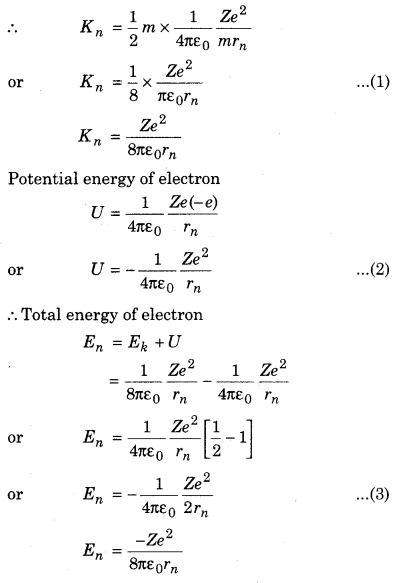
Again put the value of rn from equation (4) in article number 14.3.1.
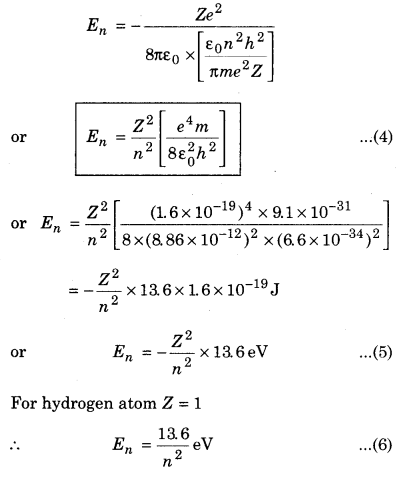
Question 4.
On the basis of Bohr atomic model explain the line spectrum of hydrogen atom.
Answer:
Linear spectrum is obtained from gases and metal vapour while it is in atomic stage so the linear spectrum is also called an atomic spectrum.
Line Spectrum of Hydrogen and Its ’ Explanation:
When an atomic gas or vapour is excited at low pressure, usually by passing an electric current through it, the emitted radiation has a spectrum which contains certain specific wavelength only. A spectrum of this kind is termed as emission line spectrum and it consists of bright lines on a dark background. The spectrum emitted by atomic hydrogen is shown in figure.
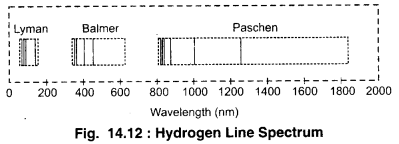
Study of emission line spectra of a material can therefore serve as a type of ‘fingerprint’ for identification of the gas. When white light passes through a gas and we analyse the transmitted light using a spectrometer we find out the some dark lines in the spectrum. These dark lines correspond precisely to these wavelengths which were found in the emission line spectrum of the gas. This is called the absorption spectrum of the material of the gas.
John Balmer proposed that observed other lines wavelength can be expressed by the equation
λ = \(\frac{364.56 n^{2}}{n^{2}-4}\) …………….. (1)
where, n = 3, 4, 5, ………..
λ is in nm. The series found in this way is called Balmer series. Other lines of Balmer series are found in near ultraviolet region. After some time Rydberg make this formula in simple form as
\(\frac{1}{\lambda}=R\left(\frac{1}{2^{2}}-\frac{1}{n^{2}}\right)\)
where, n = 3,4,5, … ……………… (2)
Where R is a constant, called as Rydberg constant, if λ is in metre, then
R = 1.09737 × 107 m-1 ≈ 107 m-1
Other series of spectra for hydrogen were subsequently discovered. These are known, after their discoveries, as Lyman, Paschen, Brackett and Pfund series. These are represented by the formulae :
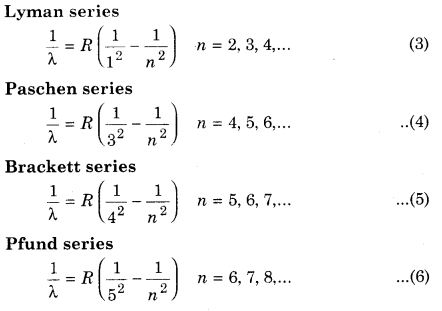
Question 5.
Write shortcomings of Bohr’s model. Show that Bohr’s second postulate of orbital quantisation can be explained on the basis of De-Broglie hypothesis of wave nature of electron.
Answer:
Limitations of Bohr Model
Bohr model has many limitations. Some are given here :
- The Bohr model is applicable to hydrogenic atoms. It cannot be extended even to more two electron atoms such as helium. The analysis of atoms with more than one electron was attempted on the lines of Bohr’s model for hydrogenic atoms but did not meet with any success. Difficulty lies in the fact that each electron interacts not only with the positively charged nucleus but also with all other electrons.
- It does not explain why only circular orbits should be chosen when elliptical orbits are also possible.
- In the spectrum of hydrogen, certain spectral lines are not single lines but a group of closed lines with slightly different frequencies. Bohr’s theory could not explain these fine structures of the hydrogen spectrum.
- Bohr’s theory does not tell anything about the relative intensities of the various spectral lines. Bohr’s theory predicts only the frequencies of these lines.
- It does not explain the further splitting of spectral lines in a magnetic field (Zeeman effect) or in an electric field (Stark effect).
- The formulation of Bohr model involves electrical force between positively charged nucleus and electron. It does not include the electrical forces between electrons which necessarily appear in multi-electron atoms.
Explanation of Bohr’s Second Postulate by de-Broglie Theory
In 1927, Louis de-Broglie argued that the electron in its circular orbit, as proposed by Bohr’ must be seen as a particle wave. In analogy two waves travelling on a string particle wave can lead to standing waves under resonant condition. We know that when a string is plucked a vast number of wavelengths are excited. However only those wavelengths survive which have nodes at the ends and form the standing waves in the string. It means that in a string, standing waves are formed when the total distance travelled by a waves down the string and back is one wavelength, two wavelengths, or any integral number of wavelengths. Waves with other wavelengths interfere with themselves upon reflection and their amplitudes quickly drop to zero. For an electron moving in nth circular orbit of radius rn . The total distance is the circumference of the orbit, 2πrn Thus, 2πrn = nλ, n = 1, 2, 3, …. …………. (1)
Figure 14.15 illustrates a standing particle wave on a circular orbit for n = 4 i.e., 2πrn = 4λ, where λ is the De-Broglie wavelength of the electron moving in nth orbit. As λ = h/ p, where p is the magnitude of the electron’s momentum. If the speed of the electron is much less than the speed of light, the momentum is mvn. thus, λ = \(\frac{h}{m v_{n}}\) From equation (1), we have
2πrn = \(\frac{n h}{m v_{n}}\) or mvnrn = \(\frac{n h}{2 \pi}\)
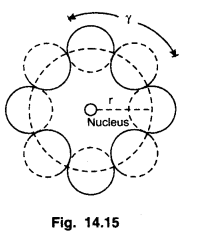
This is the quantum condition proposed by Bohr for the angular momentum of the electron. This equation is the basis of explaining the discrete orbits and energy levels in hydrogen atom. Thus de-Broglie hypothesis provided an explanation for Bohr’s second postulate for the quantisation of angular momentum of the orbiting electron. The quantised electron orbits and energy states are due to the wave nature of the electron and only resonant standing waves can persist.
Question 6.
Derive a formula for radius of the stable orbit of hydrogen atom on the basis of Bohr model. Prove that in hydrogen atom the ratio of the stable radius are 1: 4: 9
Answer:
Bohr’s Radius or Radii of Stable Orbits
Suppose for an atom the radius of nth orbit is rn and in this a electron is moving with the speed of v. If the electron has a mass of m, then acquisition by Bohr
mvnrn = \(n \frac{h}{2 \pi}\) ……………… (1)
From first condition of Bohr
Fe = Fc
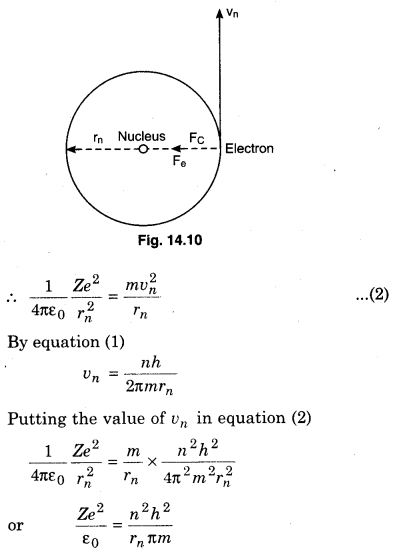
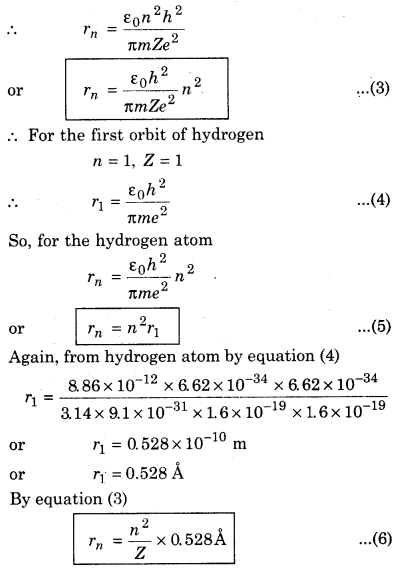
rn = n2 r1, r1 = 0.53 Å where Z = 1, for the hydrogen atom.
Where n = 1, 2, 3 ……..
r1 : r2 : r3 = (i)2r1 : (2)2r1 : (3)2r1
r1 : r2 : r3 = 1: 4 : 9 ………..
RBSE Class 12 Physics Chapter 14 Numerical Questions
Question 1.
Calculate radius of second Bohr radius of hydrogen atom and then also calculate the speed of the electron and total energy of the orbit. (Given, mass of electron m = 9 × 10-31 kg, e = 1.6 × 10-19C, h = 6.6 × 10-34)
Solution:
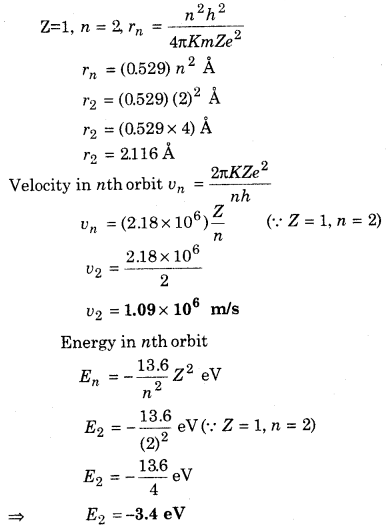
Question 2.
If wavelength of the first line of Lyman series is 1216 Å, then find out wavelengths of the first lines of Balmer and Paschen series.
Solution:
For Lyman series,
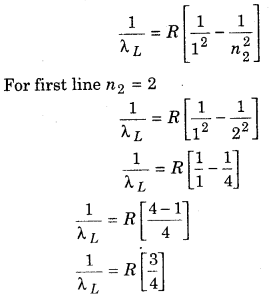
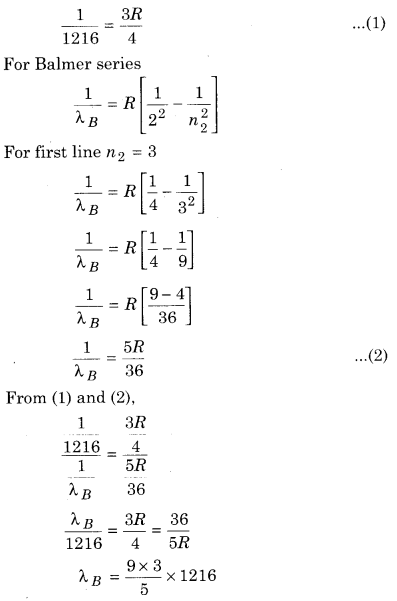
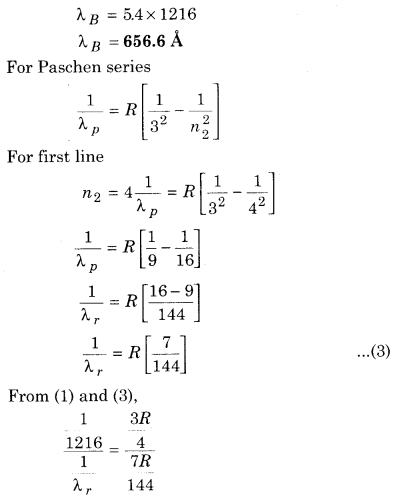
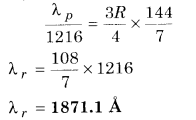
Question 3.
In atom in transition from energy state A to C 1000 Å wavelength photons are emitted and in transition from B to C energy state 5000 Å wavelength photons are emitted. What will be the wavelength of photon in transition from A to B state?
Solution:
For transition from A to C
EA – EC = \(\frac{h c}{\lambda_{1}}\) ……………… (1)
For transition from B to C
EB – EC = \(\frac{h c}{\lambda_{2}}\) ……………… (2)
For transition from A to B
EA – EB = \(\frac{h c}{\lambda_{3}}\) ……………… (2)
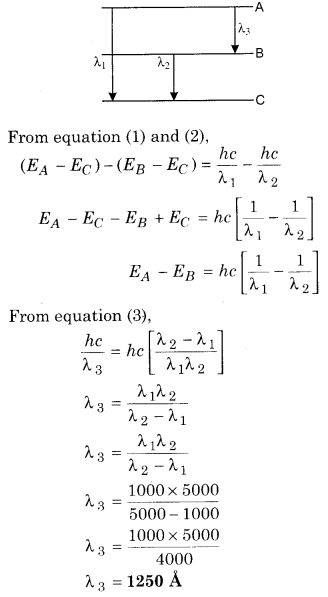
Question 4.
Doubly ionised Lithium atom whose atomic number is 3 is similar to hydrogen atom.
(i) In this atom calculate wavelength of the radiation in excitation from first orbit to third orbit.
(ii) How many spectrum lines will be observed in emission of excited system?
Solution:
(i) Electron energy in nth orbit
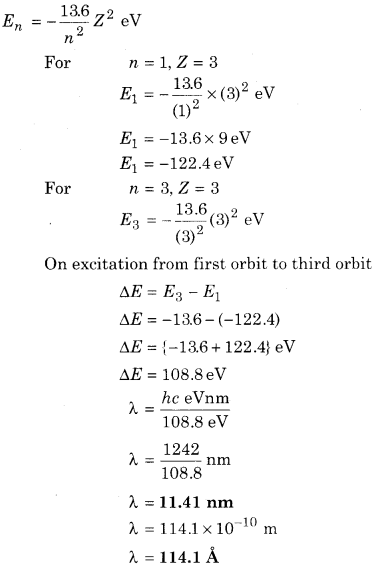
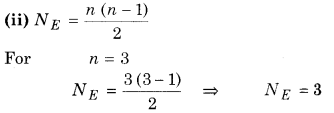
Question 5.
The wavelength of first line of Balmer series is 6564 Å, then find Rydberg constant and wave number.
Solution:
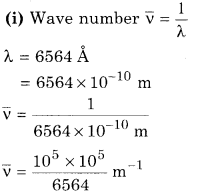
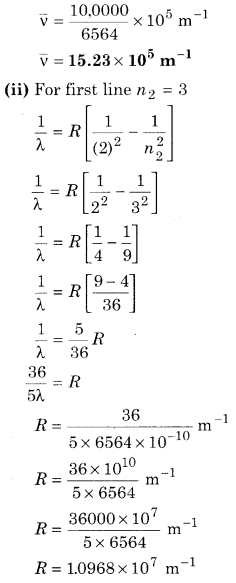
R = 1.097 × 107 m-1
Question 6.
Hydrogen similar any ion emits a radiation of 2.467 × 107 Hz frequency in transition from n = 2 to n = 1. Calculate the frequency of the radiation in transition from n = 3 to n = 1.
Solution:
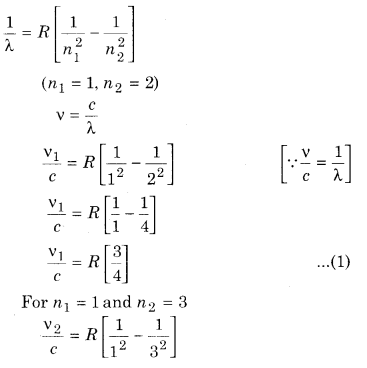
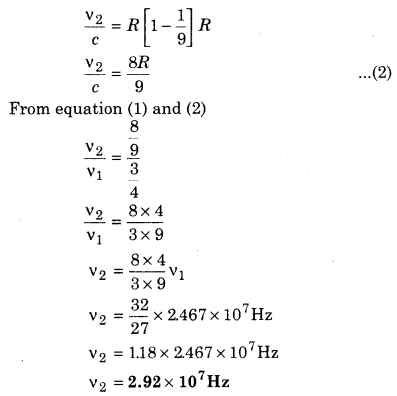
Question 7.
Monochromatic radiation of wavelength λ are incident on a hydrogen sample whose atoms are in ground state. Hydrogen atom absorbs radiation and then emit wavelengths of 6 different colours. Determine λ. (Given he = 1242 eV-nm, ground state energy of hydrogen E = -13.6 eV)
Solution:
Atom is excited from ground level to fourth energy level
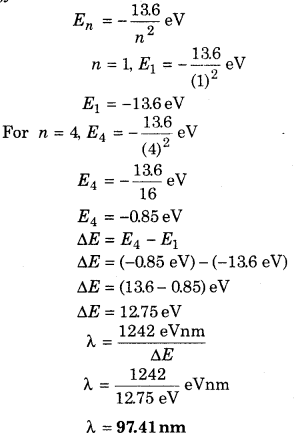
Question 8.
In hydrogen atom light corresponding to transition from n = 4 to n = 2 falls on a metal whose work function is 1.9 eV. Find out the maximum kinetic energy of the emitted photoelectrons.
Solution:
By Einstein’s relation
E = W0 + (EK)max , W0 = Work function = 1.9 eV
hv = W0 + (EK)max, (EK)max. = Maximum K.E.
\(h \frac{C}{\lambda}\) = W0 + (EK)max.
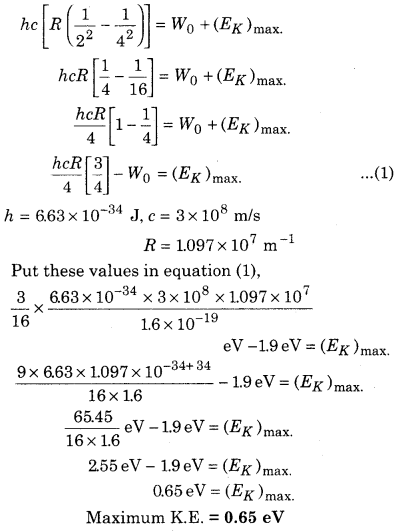
Question 9.
A sample of hydrogen is in a specific excited state A. By absorption of photons of energy 2.55 eV it reaches to another excited state B. Calculate principal quantum number for A and B.
[nA = 2, nB = 4]
Solution:
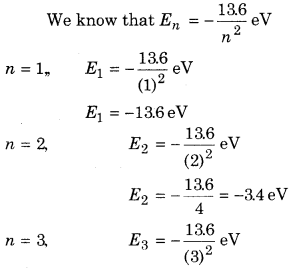
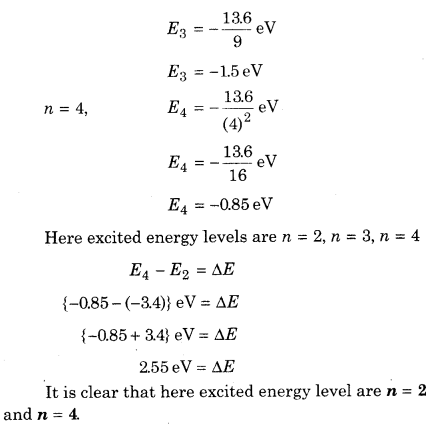
Question 10.
The energy state diagram of an atom is shown in figure given below. Calculate wavelength of photons corresponding to transition B and D.
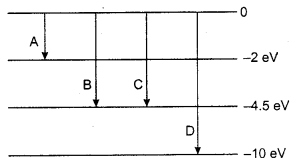
Solution:
Wavelength related to transition B
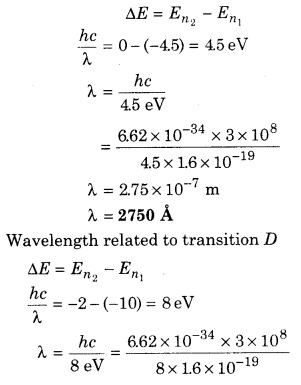
λ = 1.55 × 10-7 m
λ = 1550 Å
Question 11.
Calculate maximum angular velocity of the electron in stable orbit of a hydrogen atom.
Solution:
Radius of hydrogen atom rn = 0.529 n2 Å = 0.529n2 × 10-10 m
Velocity of hydrogen atom in orbit
vn = \(\frac{2.18 \times 10^{6}}{n} \mathrm{m} / \mathrm{s}\)
When electron revolves in stationary orbit then angular velocity is ωn
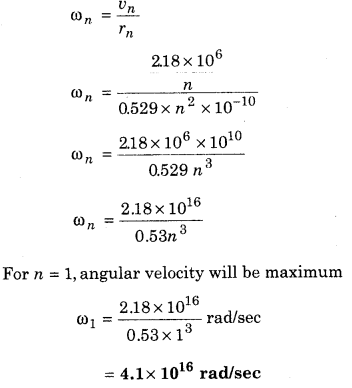
Question 12.
What will be the recoiling momentum of hydrogen atom in going from n = 5 state to 71 = 1 state after emission of photon?
(Given, R = 1.097 × 107 m-1, h = 6.63 × 10-34 J-s and mass of hydrogen = 1.67 × 10-27 kg).
Solution:
According to law of momentum conservation, momentum of recoiled hydrogen atom = momentum of emitted photon
